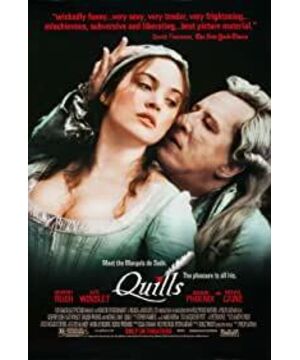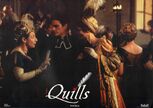In the depths of the dark soul, there are countless undercurrents, and we swear that we will keep our hearts firmly, and whether we will not get lost when we venture into it. God made our souls live in the skins of the flesh, and human nature became a combination of divinity and animal nature. The way to ascension is to approach the divinity, but to fall into the opposite side in the process of getting lost. When you read the same text, different people will read it differently, so remind you if you are prepared before watching this movie, so as not to be tempted by the undercurrent of dark songs.
"The Quill" is the most superb acting work of Australian film emperor Geoffrey Rush, and the wonderful plot has made a classic forbidden fruit film. The film tells the life of Geoffrey Rush, a double title rogue master in the Napoleonic era of France. The originator of pornography and SM, with a life full of controversy, is he a liberal master or a morally depraved hooligan? And what we see is a kind of human nature.
The beginning of the film is a bloody beheading. The camera is revealed with the guillotine falling to a girl, penetrating the scarlet blood plasma, and we start the film. A church asylum is in charge of a notorious Marquis de Sade, who has an unquenchable desire to create and writes a lot of pornographic literature, which is full of various sexual elements and has a strong sense of responsibility for those in power. , the mockery of religious divinity. With a full spiritual life, even if Sade loses the freedom of the body, the soul is still wandering freely. Kate Winslet played the washerwoman in the church asylum and became a loyal fan of Sade. She passed the manuscript for the Marquis of Sade, and the manuscript circulated secretly in the society. In the end, the real text angered Napoleon, who was in power, and he sent a brutal psychiatrist.
Michael Caine plays the morally hypocritical psychiatrist.
The young priest of the church, Colmer, loves the washerwoman, but at the same time represses his lust. Although he didn't like Sade's words, he still tolerantly gave him the space to create. He wanted to send other people's souls for redemption based on religious feelings. This character eventually turned to his own opposite.
Under the pressure of secular power, Father Kaulmai tried his best to organize Sade's creation, but the Marquis of Sade burst out his creative inspiration even more uncontrollably under this pressure. He used red wine to write on the sheets, he He pierced his own blood and wrote on his clothes, and those words could still continue to be transmitted like radio waves.
Behind the seemingly provocative text is the liberation of the souls who are suffering from repression. Under the precepts, the young priest did not dare to release the true desire in his heart, the cowardly cowardly in love.
The old psychiatrist married a young and beautiful nun as his wife, and under the influence of Sade's writing, she also rose up to resist and run away with others. The enraged authorities began to persecute Sade physically, but still could not curb his creative desire. On a stormy night, the spiritual pillar of this crazy and oppressive world wants to complete the most erotic creation in his life. Through the small holes dug in the walls of these mentally ill people, he completed one of his peak works, telling the story by word of mouth, and then transcribing it by the washerwoman. The seductiveness of the story caused a psychotic episode who had always been obsessed with the laundress, and finally killed this infatuated and pure girl.
The young priest became mad. He cut off the Marquis of Sade, but in the end he was unable to complete his redemption. The Marquis of Sade still used his own feces and excrement to create works on the walls. At the last moment of his life, the priest still wanted to redeem, but as Sade laughed at him when he stripped his last clothes: "Your God is so weak and incompetent." The Marquis of Sade did not kiss, but It was suicide by swallowing the priest's cross. He was completely free in spirit until his death.
The spirit of Sade's works is magically fermented, and the priest goes crazy and asks himself. The most bizarre stream-of-consciousness scene in the movie is when the priest looks beside Meidelian's naked corpse. The corpse is suddenly resurrected and the two of them have sex once, but it switches to the priest lying on the bed by himself and lusting for a corpse rape. This scene overlaps with Sade's text, and the soul seems to be possessed by the priest. He finally lives in the room where Sade is locked up, and starts his creation with a quill sent by the old washerwoman. The film ends with an ironic scene where hypocritical psychiatrists begin to organize mentally ill people to print Sade's works and make huge profits. Moral admonitions, the hatred of losing a wife, everything is a cloud in the face of money and real interests.
The complexity of the character of Sade is difficult to judge simply by virtue of morality, a genius of language, and a quixote in the world of pornography, although in his confrontation with powerful secular authorities he Like many idealists, he still suffers from failure and even destruction, but this unique spiritual temperament still has a unique charm. It has been passed down to later generations. He is also regarded as a master of sexology by later generations. his name.
Art creation follows its own artistic laws, it does not always satisfy moral teachings, and the education itself of all dogmas depends on whether it is based on human nature or whether human nature is spontaneously approaching perfection, rather than suppressing and distorting. I think this is a kind of revelation given by the film at the philosophical and artistic level.
View more about Quills reviews











